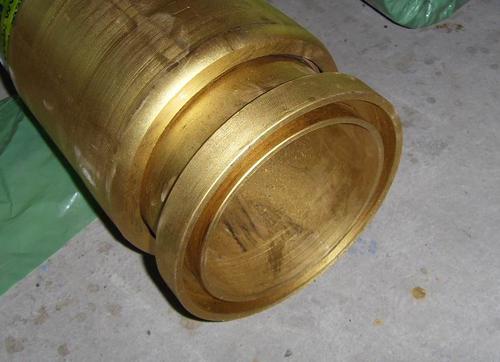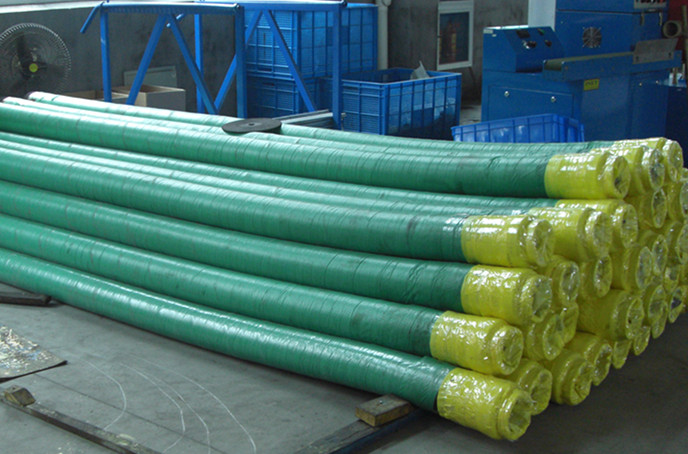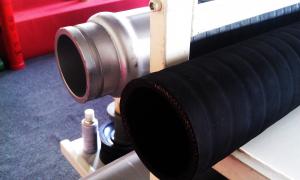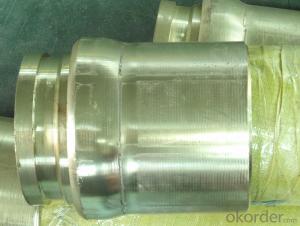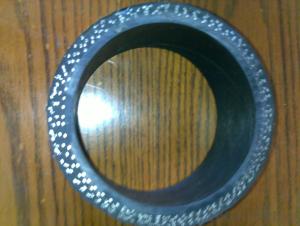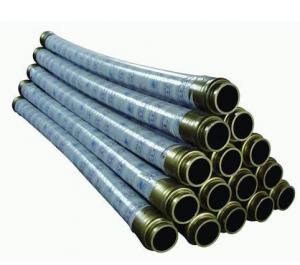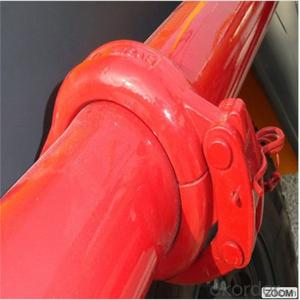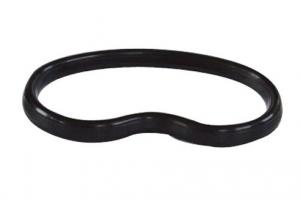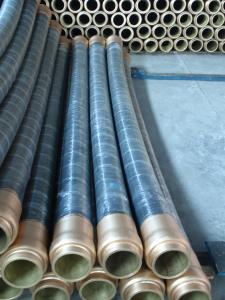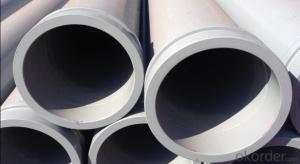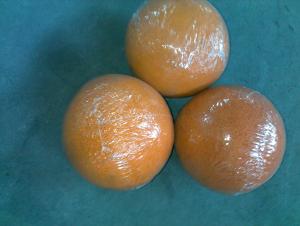Concrete Pump Rubber End Hose with Schwing Coupling
- Loading Port:
- Shanghai
- Payment Terms:
- TT OR LC
- Min Order Qty:
- 1 PCS
- Supply Capability:
- 1000 PCS/month
OKorder Service Pledge
OKorder Financial Service
You Might Also Like
Product Description:
1. Specification
Name | Concrete rubber hose; Delivery hose; End hose; Concrete pump hose; Boom hose |
Size | 2"/2.5"/3"/3.5"/4"/4.5"/5"/6"or according to client’s requirement |
Length | 3M,5 or Any length |
Reinforcement | Steel wire, tire cord or fabric |
Hose End | Galvanized, inner wall harden |
Application | Schwing, Putzmeister, Sany, Zoomlion, etc |
2. Application
1.Applacation:delivery concrete
2.Suitable for the various :Schwing, CIFA,PM, Zoomlion ,SANY and so on.
3. Package
Put into containers.
FAQ:
Q1: Why buy Materials & Equipment from OKorder.com?
A1: All products have its ISO certifications, adheres to the highest standards and a commitment to supply chain safety and customer satisfaction.
Q2: How do we guarantee the quality of our products?
A2: We have established an advanced quality management system which conducts strict quality tests at every step, from raw materials to the final product. At the same time, we provide extensive follow-up service assurances as required.
Q3: How soon can we receive the product after purchase?
A3: Within three days of placing an order, we will begin production. The specific shipping date is dependent upon international and government factors, but is typically 10 to 30 workdays.
Q4: If we can produce Concrete Pump Rubber End Hose with Schwing Coupling according to customers request?
A4: Yes, we can produce Concrete Pump Rubber End Hose with Schwing Coupling according to the difference country situations to make it suitable to the market and customers. We have very professional technical team to make the design.
Q5: How to make a quick resolution for after service?
A5: We have overseas branches all-around of world, If needed, the seller shall dispatch 2 engineers to the buyer's site for supervision of training. The buyer shall make available of necessary facilities &skilled personnel at site for training.
Image:
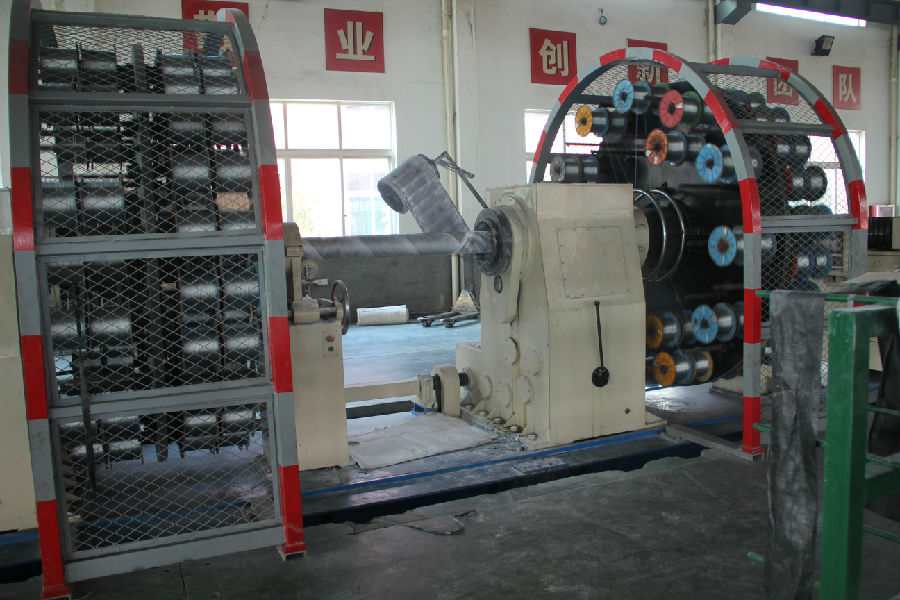
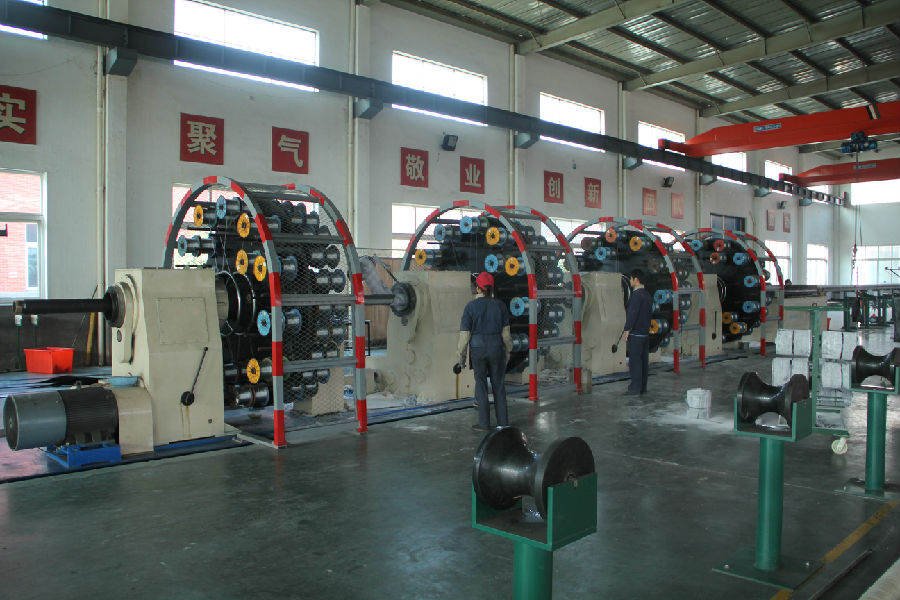

- Q: How often should concrete pump pistons be inspected and replaced?
- To ensure optimal performance and prevent malfunctions, it is necessary to regularly inspect and replace concrete pump pistons. The frequency of these inspections and replacements depends on various factors, such as the type and volume of concrete being pumped, as well as the operating conditions of the pump. As a general rule, it is recommended to inspect and replace concrete pump pistons every 500 to 1,000 hours of operation. However, this can vary based on the specific recommendations of the pump manufacturer, the quality of the concrete being pumped, and the maintenance and cleaning practices followed. Regular inspections should be conducted to identify any signs of wear, damage, or deterioration in the pistons. This includes examining the rubber seals, valve plates, and other components that may impact the piston's performance. If any cracks, tears, or excessive wear are detected, immediate replacement is necessary to prevent issues like concrete leakage or pressure loss. In addition to regular inspections, it is essential to follow a preventive maintenance schedule that includes routine cleaning and lubrication of the pistons. This will help extend their lifespan and ensure smooth operation. It is important to note that the recommended intervals for inspection and replacement may vary among different pump manufacturers. Therefore, it is advisable to consult the pump's operation and maintenance manual or seek guidance from the manufacturer or a qualified technician to determine the ideal frequency for inspecting and replacing concrete pump pistons.
- Q: How does a hydraulic accumulator improve the performance of a concrete pump?
- To ensure a constant and reliable flow of concrete, a hydraulic accumulator is employed to enhance the performance of a concrete pump. The primary role of this hydraulic device is to store hydraulic energy in the form of pressurized fluid. In the case of a concrete pump, it stores and releases energy from the hydraulic system as needed during the pumping process. Efficiency and productivity in concrete pumping rely on a consistent flow of concrete. However, variations in demand or pressure fluctuations can pose challenges. This is where the hydraulic accumulator comes into play. By storing surplus hydraulic energy, the accumulator acts as a buffer, smoothing out any irregularities in the hydraulic system. When additional power is required, the stored energy is released, providing a boost to the hydraulic system. This ensures a continuous and steady flow of concrete, even during periods of high demand or pressure changes. Furthermore, hydraulic accumulators also contribute to reducing wear and tear on the pump components. By absorbing and dampening pressure shocks, they prevent sudden spikes and fluctuations from reaching the pump. This helps to extend the pump's lifespan and minimize the risk of breakdowns or damage. Overall, a hydraulic accumulator plays a critical role in enhancing the performance of a concrete pump. It ensures a steady flow of concrete, reduces pressure fluctuations, and protects the pump from excessive wear and tear. This results in improved efficiency, reliability, and durability of the pump, ultimately leading to increased productivity and cost savings in concrete pumping operations.
- Q: Can concrete pump spare parts be coated with UV-resistant coatings for outdoor applications?
- Concrete pump spare parts can benefit from the application of UV-resistant coatings to protect them from the damaging effects of UV radiation. These coatings are specially designed to prevent fading, cracking, and deterioration over time. By coating the spare parts, they are shielded from prolonged exposure to sunlight and other environmental factors, thus extending their lifespan and ensuring optimal performance outdoors. Furthermore, these coatings offer additional protection against weathering, including moisture, temperature fluctuations, and chemical exposure. As a result, it is highly recommended to coat concrete pump spare parts with UV-resistant coatings in order to enhance their durability and maintain their functionality when used outside.
- Q: How long does it take to receive concrete pump spare parts after ordering?
- The time it takes to receive concrete pump spare parts after ordering can vary depending on several factors. It is important to note that the availability of the specific spare parts you need and the location of the supplier can significantly impact the delivery time. In general, if the spare parts are readily available and in stock, you can expect to receive them within a few days to a week. This assumes that the supplier has a streamlined order processing system and prompt shipping arrangements. However, if the spare parts are not in stock, it may take longer to receive them. In such cases, the supplier may need to order the parts from a manufacturer or source them from a distributor. This could add additional lead time to the delivery process, ranging from a few weeks to several months, depending on the availability and sourcing process. It is advisable to check with the supplier or manufacturer before placing the order to get an estimate of the delivery time. Factors like the supplier's location, transportation mode, and any potential customs or logistics delays should also be taken into consideration. To expedite the delivery process, some suppliers may offer expedited shipping options at an additional cost. This can be beneficial if you need the spare parts urgently. Overall, the time it takes to receive concrete pump spare parts after ordering can vary, but being proactive, communicating with the supplier, and planning ahead can help ensure a smoother and quicker delivery process.
- Q: What is the first generation pumping technology of concrete pump?
- Electronically controlled reversing technology, PLC control solenoid valve reversing to achieve the pump, S pipe distribution of alternating direction
- Q: How do I properly maintain and replace rubber pistons in concrete pump spare parts?
- To guarantee efficient pump operation and extend equipment lifespan, it is imperative to maintain and replace rubber pistons in concrete pump spare parts. Below are guidelines for proper maintenance and replacement: 1. Regularly Inspect: Regularly examine the rubber pistons to detect any wear or damage. Look for visible signs of deterioration such as cracks, tears, or other forms of degradation. 2. Thorough Cleaning: Prior to replacing the rubber pistons, thoroughly cleanse the surrounding area. Remove any dirt, debris, or concrete residue that may be present. This will prevent contamination and ensure a proper fit for the new pistons. 3. Adequate Lubrication: Apply a suitable lubricant to the rubber pistons to guarantee smooth operation and reduce friction. This will prolong the pistons' lifespan and prevent premature wear. 4. Proper Installation: When replacing the rubber pistons, ensure correct installation in accordance with the manufacturer's instructions. Utilize appropriate tools and techniques to avoid damaging the pistons or other pump components. 5. High-Quality Replacement Parts: Always opt for reputable suppliers and utilize high-quality replacement rubber pistons. Inferior quality pistons may not perform optimally and could result in frequent replacements or pump damage. 6. Regular Maintenance: Establish a regular maintenance schedule for your concrete pump, including the rubber pistons. This may involve cleaning, lubrication, and inspection of the pistons to identify potential wear or damage before they become major issues. 7. Training and Expertise: Ensure that the individual responsible for maintaining and replacing the rubber pistons possesses the necessary training and expertise. This will ensure proper execution of the task and minimize the risk of pump damage or personnel injury. By adhering to these guidelines, you can effectively maintain and replace rubber pistons in concrete pump spare parts, thereby ensuring optimal equipment performance and longevity.
- Q: What are the indications of a weak or dead remote control battery?
- The signs of a weak or dead battery in a remote control can vary depending on the type of remote control used. Nevertheless, there are some common signs to look out for. One of these signs is a noticeable decrease in the operating range or distance of the remote control. This means that you may need to be closer to the device you want to control for the remote to work properly. Another sign is when the remote control buttons become unresponsive or require multiple presses to function. Additionally, you may observe a delay in the response time of the device when using the remote control. In certain cases, the remote control may stop functioning altogether, indicating that the battery is completely dead. If you notice any of these signs, it is advisable to replace the battery in the remote control to ensure reliable performance.
- Q: How do concrete pump spare parts contribute to the overall performance of the pump?
- Enhancing the overall performance of the pump, concrete pump spare parts play a crucial role. These spare parts are specifically designed to endure the harsh and demanding conditions of pumping concrete, guaranteeing the efficiency and longevity of the pump. An important factor in the pump's overall performance is the ability of concrete pump spare parts to enhance pumping capacity and efficiency. These spare parts, including pump cylinders, pistons, and valves, are designed to ensure a consistent and smooth flow of concrete without any interruptions. By maintaining a steady flow, these spare parts maximize the pump's capacity, enabling it to handle larger volumes of concrete in less time. Furthermore, concrete pump spare parts contribute to the pump's performance by improving its durability and reliability. These spare parts are made from high-quality materials like hardened steel and wear-resistant alloys, specifically chosen to withstand the abrasive nature of concrete. This ensures that the pump can operate continuously without experiencing premature wear or failure. Concrete pump spare parts also ensure the safety of the pump operators and the environment. For instance, wear plates and cutting rings prevent concrete leakage, reducing the risk of accidents and environmental contamination. Similarly, seals and gaskets provide a secure and tight connection between different components, preventing leaks or malfunctions. Moreover, concrete pump spare parts reduce downtime and maintenance costs. As these spare parts undergo wear and tear during operation, they are designed to be easily replaceable. This allows for quick and efficient repair or replacement of damaged parts, minimizing the pump's downtime. Additionally, using genuine and high-quality spare parts reduces the need for frequent repairs and maintenance, resulting in lower overall maintenance costs. In conclusion, concrete pump spare parts are vital components that significantly contribute to the pump's overall performance. They enhance its pumping capacity, durability, and reliability, ensuring a smooth and efficient operation. Furthermore, these spare parts promote safety, reduce downtime, and minimize maintenance costs, making them indispensable for the optimal performance of concrete pumps.
- Q: How can one determine the correct weight and balance requirements for concrete pump spare parts?
- To ascertain the appropriate weight and balance specifications for concrete pump spare parts, several factors must be taken into account. First and foremost, consulting the manufacturer's specifications and guidelines specific to the concrete pump model is of utmost importance. These documents typically contain comprehensive information regarding the weight and balance requirements for each spare part. Secondly, it is essential to comprehend the function and purpose of each spare part. Different components vary in weight and can significantly impact the overall balance of the pump. For example, larger elements like booms or outriggers may necessitate precise weight distribution to ensure operational stability. Moreover, considering the intended usage and environmental conditions of the concrete pump is imperative. If the pump is expected to operate in challenging terrains or extreme weather, additional weight might be necessary to enhance stability. In addition to the manufacturer's guidelines, seeking counsel from experts or engineers knowledgeable about concrete pumps can provide invaluable insights. These professionals can analyze the specific requirements of the pump and offer guidance on the appropriate weight and balance specifications for the spare parts. Lastly, conducting thorough testing and inspections after installing any spare parts is crucial. This ensures compliance with the weight and balance requirements and allows for any necessary adjustments to be made. In conclusion, determining the correct weight and balance requirements for concrete pump spare parts necessitates a combination of understanding manufacturer guidelines, considering the purpose and conditions of the pump, seeking expert advice, and performing comprehensive testing and inspections.
- Q: What are the common causes of overheating in concrete pump spare parts?
- Concrete pump spare parts can overheat due to various common causes. One primary reason is improper lubrication, which results in increased friction and overheating of the pump's moving parts like bearings and pistons. To prevent this, it is essential to regularly inspect and maintain the lubrication system to ensure smooth operation. Excessive use or continuous operation without breaks is another common cause of overheating. Concrete pumps have a designated workload, and surpassing it or neglecting proper rest periods can lead to overheating of the components. To avoid this, it is crucial to adhere to recommended operating guidelines and periodically allow the pump to cool down. Additionally, overheating can occur due to clogged or blocked cooling systems. The cooling system in a concrete pump regulates temperature by circulating coolant around vital parts. If the system gets clogged or the coolant level is insufficient, overheating may occur. Regular inspection, cleaning, and maintaining appropriate coolant levels can prevent this issue. Inadequate ventilation is also a common cause of overheating. Concrete pumps generate substantial heat during operation, and if the surrounding environment lacks proper airflow, the heat cannot dissipate effectively. This can lead to overheating of spare parts. To avoid this, it is important to operate the pump in well-ventilated areas or utilize additional cooling measures like fans or air conditioning. Lastly, a malfunctioning or damaged pump component can cause overheating. When a part such as the motor or hydraulic system does not function correctly, it places additional strain on other components, resulting in overheating. Regular maintenance and inspection of the pump's components can help identify and address any potential issues before they lead to overheating. In conclusion, preventing overheating in concrete pump spare parts requires proper lubrication, adherence to operating guidelines, maintenance of cooling systems, ensuring adequate ventilation, and regular component inspection.
Send your message to us
Concrete Pump Rubber End Hose with Schwing Coupling
- Loading Port:
- Shanghai
- Payment Terms:
- TT OR LC
- Min Order Qty:
- 1 PCS
- Supply Capability:
- 1000 PCS/month
OKorder Service Pledge
OKorder Financial Service
Similar products
Hot products
Hot Searches
Related keywords



